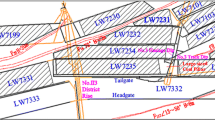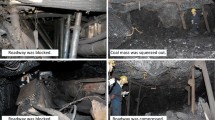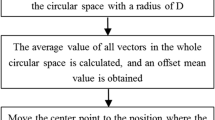Abstract
Rock burst prediction method for coal mining is one of the worldwide challenging problems. Based on a high precision microseismic monitoring system consisting of nine geophones installed in Qixing Coal Mine in China, abundant microseismic events were detected through the continuous monitoring for 80 days. The potential high risk areas of rock burst were determined by analyzing the spatial and temporal distribution characteristics of microseismic events, which provides the basis for the early risk warning during the mining process. After a comprehensive analysis of the spatial and temporal evolution characteristics of the microseismic events, a prediction model for rock burst prediction was built based on the principles of seismology and rock mechanics by setting four indicators as prediction parameters, such as the average number of microseismic events N, the average released energy E, the decrease Δb of the seismological parameter b, and the potential maximum seismic magnitude M m. It was found that all the four prediction indicators are useful for predicting rock burst but they could vary greatly in efficiency in the practical engineering applications.









Similar content being viewed by others
References
Alvarez-Ramirez J, Echeverria JC, Ortiz-Cruz A, Hernandez E (2012) Temporal and spatial variations of seismicity scaling behavior in Southern Mexico. J Geodyn 54:1–12. doi:10.1016/j.jog.2011.09.001
Driad-Lebeau L, Lahaie F, Heib MA, Josien JP, Bigarre P, Noirel JF (2005) Seismic and geotechnical investigations following a rockburst in a complex French mining district. Int J Coal Geol 64:66–78. doi:10.1016/j.coal.2005.03.017
Husen S, Kissling E, Deschwanden AV (2013) Induced seismicity during the construction of the Gotthard Base Tunnel, Switzerland: hypocenter locations and source dimensions. J Seismol 17:63–81. doi:10.1007/s10950-011-9261-8
Jiang YD, Pan YS, Jiang FX, Dou LM, Ju Y (2014) State of the art review on mechanism and prevention of coal bumps in China. J China Coal Soc 39(2):205–213. doi:10.13225/j.cnki.jccs.2013.0024
Lesniak A, Isakow Z (2009) Space-time clustering of seismic events and hazard assessment in the Zabrze-Bielszowice coal mine, Poland. Int J Rock Mech Min Sci 46:918–928. doi:10.1016/j.ijrmms.2008.12.003
Li JR, Song B, Cui JY (2015) Seismic dynamic damage characteristics of vertical and batter pile-supported wharf structure systems. Journal of Engineering Science and Technology Review 8(5):180–189. doi:10.14006/j.jzjgxb.2016.07.019
Li SG, Lv JG, Jiang YD, Jiang WZ (2014) Coal bump inducing rule by dip angles of thrust fault. Journal of Mining & Safety Engineering 31(6):869–875
Lu JT, Yang ND, Ye JF, Liu XG, Mahmood N (2015) Connectionism strategy for industrial accident-oriented emergency decision-making: a simulation study on PCS model. International Journal of Simulation Modelling 14(4):633–646. doi:10.2507/IJSIMM14(4)6.315
Ma TH, Tang CA, Tang LX, Zhang WD, Wang L (2016) Mechanism of rock burst forcasting based on micro-seismic monitoring technology. Chin J Rock Mech Eng 25(3):470–483. doi:10.13722/j.cnki.jrme.2014.1083
Mansurov VA (2001) Prediction of rockbursts by analysis of induced seismicity data. Int J Rock Mech Min Sci 38:893–901. doi:10.1016/S1365-1609(01)00055-7
McKinnon SD (2006) Triggering of seismicity remote from active mining excavations. Rock Mech Rock Eng 39(3):255–279. doi:10.1007/s00603-005-0072-5
Pastén D, Estay R, Comte D, Vallejos J (2015) Multifractal analysis in mining microseismicity and its application to seismic hazard in mine. Int J Rock Mech Min Sci 78:74–78. doi:10.1016/j.ijrmms.2015.04.020
Šílený J, Milev A (2008) Source mechanism of mining induced seismic events—resolution of double couple and non double couple models. Tectonophysics 456:3–15. doi:10.1016/j.tecto.2006.09.021
Xia YX, Kang LJ, Qi QX, Mao DB, Ren Y, Lan H, Pan JF (2010) Five indexes of microseismic and their applications in rock burst forecast. J China Coal Soc 35(12):2011–2016
Yin XC, Li SY, Li H, Wang M (1987) On the physical essence of b value for AE of rock tests and natural earthquakes in terms of fracture mechanics. Acta Seismol Sin 9(4):364–374. doi:10.1007/BF02652408
Yu Q, Tang CA, Li LC, Li H, Cheng GW (2014) Nucleation process of rockbursts based on microseismic monitoring of deep-buried tunnels for Jinping II Hydropower Station. Chinese Journal of Geotechnical Engineering 36(12):2315–2322. doi:10.11779/CJGE201412021
Yuan RF, Li HM, Li HZ (2012) Distribution of microseismic signal and discrimination of portentous information of pillar type rockburst. Chin J Rock Mech Eng 31(1):80–85
Zhao YX, Jiang YD, Wang T, Gao F, Xie ST (2012) Features of microseismic events and precursors of rock burst in underground coal mining with hard roof. J China Coal Soc 37(12):1960–1966
Acknowledgements
This work was supported by the National Natural Science Foundation of China (51474188; 51074140), the Natural Science Foundation of Hebei Province of China (E2014203012), the International Cooperation Project of Henan Science and Technology Department (162102410027), the International Cooperative Talent Project of Henan Province (2016GH22), the Doctoral Fund of Henan Polytechnic University (B2015-67), and Program for Taihang Scholars. All these were gratefully acknowledged.
Author information
Authors and Affiliations
Corresponding author
Rights and permissions
About this article
Cite this article
Wang, S., Li, C., Yan, W. et al. Multiple indicators prediction method of rock burst based on microseismic monitoring technology. Arab J Geosci 10, 132 (2017). https://doi.org/10.1007/s12517-017-2946-8
Received:
Accepted:
Published:
DOI: https://doi.org/10.1007/s12517-017-2946-8




